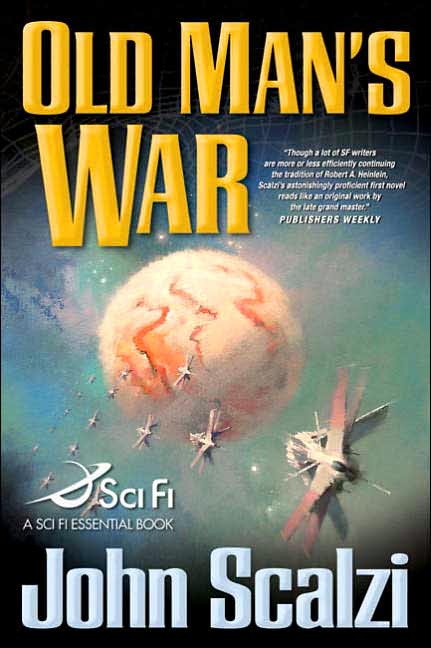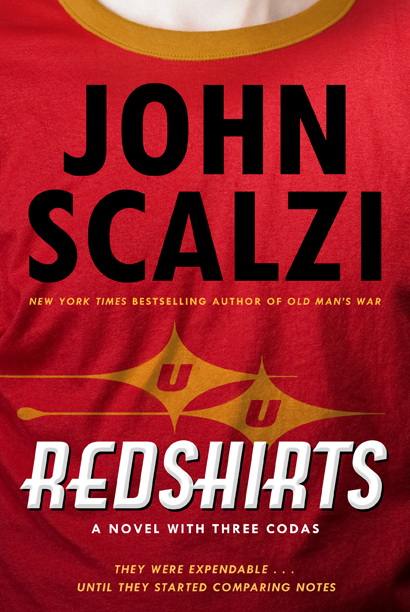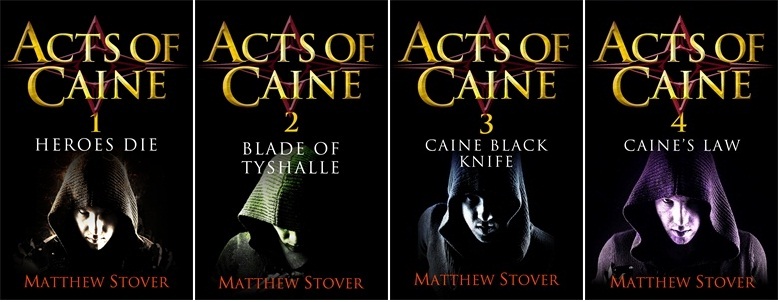John Scalzi interviews Matthew Stover about the ACTS OF CAINE
Since we heard that the illustrious John Scalzi was a super-mega-fan of the Acts of Caine novels by Matthew Stover, (which starts with HEROES DIE), we asked him if he wanted to interview Matthew . . .
When I was told that Orbit Books was releasing the entire Acts of Caine series in the UK, I let out a cheer. I am, unapologetically, a huge fan of this series of books, full as they are of action, adventure and grippingly written violence – along with classic dystopian themes, observantly written (and massively, compellingly flawed) characters, and world-building I’m jealous of as a writer even as I’m impressed with it as a reader. This is the series that put its author Matthew Stover on my map as someone whose books I had to read, no matter what he was writing.
Orbit asked me if I wanted to interview him on the occasion of the release of his books. Yes. Yes I did. Here it is.
John Scalzi: Heroes Die, the first book in the Caine series, in many ways presaged the current wave of “grimdark” fantasy – those works with lots of unapologetic action and violence threaded into their tales. At the time you were writing the book, were you aware you were slashing a new path through that particular jungle? Or were you just focused on writing a story you wanted to tell?
Matthew Stover: I wasn’t trying to do something new. I was only trying to do something good.
I started writing the story that eventually became Heroes Die when I was seventeen. A variety of versions were submitted to, and summarily rejected by, a variety of publishers over the course of the next eighteen years. I tried every approach I could think of to make the story appealing to editors, but nothing worked. Finally – in despair – I said to myself, “Screw this sh*t. If it’s going to fail anyway, write the goddamn thing exactly how you want it to be. At least you’ll have that.” So I did. And here we are.
This is why my first advice to younger writers is to write the book you wish somebody else would write so you could read it.
JS: You also, and very unusually, have created a series of books that are both science fiction and fantasy, as opposed to choosing to be on one side of that (in my opinion, often arbitrary) line. For me as a reader, that felt almost revolutionary – not in an excessive “have your cake and eat it too” sort of way, but in that it allows you to world-build two separate but vital universes, and build stories in the tension between the two. But from the practical point of view as a writer – well, it’s a lot of work. Talk a little about your world-building strategies and why it was you chose to straddle the two genres in this series – and the challenges you have in making sure the two universes are balanced in service to the story.
MS: It has been a lot of work. But, y’know, I wrote these four books over the course of about fifteen years, which leaves plenty of time for things to develop more-or-less organically. Much of the world-building is a by-product of thinking about other stories I might want to tell in that milieu – even if I never write the stories, their background features remain.
I chose the dual-world structure because one of the themes that seem to underlie all my original work has to do with the role of imagination in creating our experience of reality. When I was a kid, I was very taken with de Camp and Pratt’s Harold Shea stories – psychologists who find a way to transport themselves into mythical (later, outright fictional) realms through some hand-waving involving symbolic logic. These stories make crystal clear the fact (bleedingly obvious, in retrospect) that fantasy is the map of human psychology. I wanted a Real World to contrast with the Fantasy World, but I wanted the Fantasy World to be real too. After all, dreams are themselves real things, even though the experiences we have in them are products of our own imaginations (pacé various mystical traditions).
And I didn’t really choose to combine two genres, because I don’t believe they’re really separate. Science fiction is a subset of fantasy (as is all literature, after all). Heinlein wrote stories with magic in them. So did Larry Niven. And Poul Anderson. Fritz Leiber wrote some straight SF. I write stories that have (some) science and (some) social extrapolation in them. And magic too. Though I usually tell people I’m a science fiction writer, because when I tell them I write fantasy, I have to endure some variation of the following conversation:
“Really? Like Lord of the Rings?”
“No, not like Lord of the Rings.”
“Like Harry Potter, then.”
“No, like Star Wars.”
“But Star Wars is science fiction.”
“Look, what do you call it when a young knight is given his father’s magic sword by an old wizard and then sent off on a quest to defeat the Dark Lord?”
“I call it fantasy.”
“No, you call it Star Wars, Einstein. Now shut up before I unscrew your head and drop-kick it into a parallel dimension.”
JS: Caine is in himself a fascinating character: Unstoppable action hero in one universe, a complicated and in many ways a broken man in the other – someone who is hero, antihero, and pitiable creature, depending on the moment and the circumstances of the story. When did Caine first present himself to you in your head? Was he largely all the things he is as we see him in the series when you first thought of him? Or did you find him in the writing of the books? As you’ve written him, has he ever done things that have surprised you?
MS: I’m surprised every time Caine is nice to someone.
I’ve described his genesis as having been the result of a titanic migraine I had when I was seventeen, at the end of which my skull split open and out leapt Caine, full grown with a knife in each hand, pissed as hell and looking for somebody to hurt.
The truth is, he’d been with me a long time already by then. A lot of kids discharge anger by channeling it into rage-fueled revenge fantasies. (Can you say Batman? Knew you could.) So . . . Batman is a character created by Bruce Wayne as an outlet for his rage; one step removed, Batman (and Bruce Wayne) are characters created by Bob Kane as outlets for ours. Caine is one more step removed – he’s an outlet for Hari Michaelson’s rage, yes, but also he’s also a character designed and marketed by a world-wide entertainment conglomerate as a cathartic outlet for his in-universe audience, which gives me, as author, the chance to (as somebody said to me lately) have my cake and eat it too: to write a piece of violent entertainment that can also be read as a meditation on violence as entertainment in itself.
That’s what he was when I first undertook to write about him. He’s grown up some since then.
JS: The universes of Acts of Caine are dark, complex and an achievement in world-building – but you’ve also worked in other people’s universes, most notably writing a number of books in the Star Wars universe, using some of the universe’s most popular characters. For those of us who have never written in someone else’s world, compare the creative process between writing in your own worlds and writing in someone else’s, at least in your experience. Also, what do you take from the Acts of Caine that you can bring to the media work – and what can you take from the media work and bring into the Acts of Caine?
MS: For me, writing a novel is analogous to freestyling a model out of a pile of Lego bricks. I look over all the bricks in front of me – size, shape, color, how they might be put together in useful or unexpected ways – then I try to figure out how to use them to make something beautiful. The main difference in writing a tie-in is that I start with a different set of bricks.
(And occasionally, though not always, I also get some suggestions about how the licensor would like the finished model to look – which usually renders the whole project easier, as it cuts the number of decisions I have to make. Execution is easier than conceptualization.)
To extend the metaphor, you could say that in the tie in, I’m working with borrowed bricks. And that I have a professional obligation to return them in the same condition they were in when I received them. If I can manage to use those borrowed bricks to make something that people didn’t think could be made with them, well . . . that’s kind of what I live for.
And that’s the whole thing. You build a model with somebody else’s Legos. Beyond that, the process is exactly the same. What I learn from tie-ins, I guess, is how to see the underlying physics of Lego construction for what it is in itself, entirely divorced from the details of each individual set of bricks.
JS: This is a cliché question, but then I’m a fan and I really want to know: What’s next for Matthew Stover?
MS: Something different, and then more of the same. I’m trying to pull together the ending of a hard-boiled contemporary crime thriller, as well as driving through to the end of another tie-in. After that, well . . . I have three different SFF projects in various stages of development, each as different from the others as they are from the Acts of Caine.
And if Orbit’s launch of the Acts of Caine results in a world-wide clamor for more stories about a certain charismatic homicidal sociopath with serious anger issues . . . well, I’m ready for that too.
John Scalzi is best know for his Old Man’s War series, and has recently recently released a new novel REDSHIRTS to much acclaim. His blog Whatever can be found here.


Matthew Stover is the author of the Acts of Caine novels. The whole series is now available digitally, with Book 1 HEROES DIE currently at a promotional introductory price. Find Matthew Stover on Facebook here.

